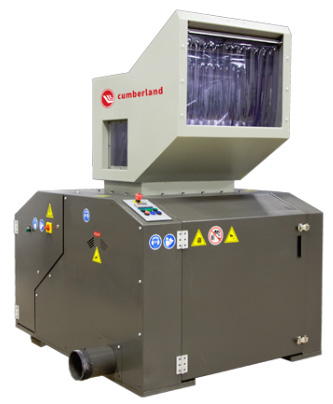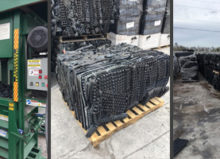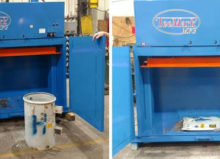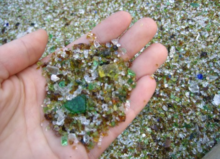What is Size Reduction in Plastic Recycling?
The overall goal of most plastic recycling programs is to turn scrap and non-conforming parts back into a similar size and form to the virgin material being processed. This “regrind” will often have the proper material characteristics, such as strength or optical qualities, to be blended with the original resin. This can then be reused to make more parts. It’s both cost efficient and environmentally friendly. Plastics processors use size reduction equipment for a variety of reason, but generally alongside injection molding, blow molding, extrusion, and thermoforming processes. It’s also used for general recycling purposes.
Common Materials include:
- Acrylics
- Acrylonitrile Butadiene Styrene (ABS)
- High-density polyethylene (HDPE)
- High-Impact Polystyrene (HIPS)
- Linear low-density polyethylene (LLDPE)
- Low-density polyethylene (LDPE)
- Nylon
- Polycarbonate (PC)
- Polyether Ether Ketone (PEEK)
- Polyethylene terephthalate (PET, PETE)
- Polylactic acid (PLA)
- Polypropylene (PP)
- Polystyrene (PS)
- Polyvinyl chloride (PVC/vinyl)
The size reduction equipment most commonly used by plastics processors are: Granulators
 What is a (the machine) granulator?
What is a (the machine) granulator?
Granulators are very effective at reprocessing sprues, runners, and small to medium size parts. They typically generate particles from 1/8” to 3/4” in size, though most granulate runs between ¼” and 3/8”. Granulators are most commonly found near injection molding machines but are also used with other processes such extrusion, blow molding and thermoforming. The three common types of granulators are: beside-the press, central and special units designed primarily for thermoforming. But there are many more granulator technology options which customize a unit to fit any broad or specific application.
When you need plastic particles reduced to fractions of an inch, plastic granulators are the perfect solution. With beside-the press, central, heavy-duty, and thermoforming granulators, Compactors Inc provides several options designed to suit your specific needs. With beside-the press, central, heavy-duty, and thermoforming granulators, Cumberland provides several options designed to suit your specific needs.
Who would benefit from a granulator?
Plastics Industry, Automotive Production Lines, Recycling Facilities
Granulator FAQs
Q) What is quality regrind?
A) Quality regrind may look different for different applications. But, a good rule of thumb is looking for consistent, uniform granulate size with minimal sharps and low dust. Material density will dictate if the regrind is a flake or granulate. Whereas screen size may dictate the particle size, the end goal is to reclaim as much quality, useable regrind to minimize additional virgin material and recycle back into the process and mitigate waste.
Q) How many rotor knives should I use and why?
A) This typically depends on the size and density of the parts. The goal is to use enough knives to maximize throughput without sacrificing part ingestion into the cutting area. More knives mean more cuts per minute, however, there are diminishing returns after a certain threshold where parts/material will bounce around in the chamber rather than allowing the knives to “bite” on the downstroke.
Q) What determines how many bed knives to use?
A) Generally, the material characteristics and throughput requirements will dictate how many knives to use and in what configuration.
Q) When to use steep-angle knife design?
A) Maximizes cutting function for higher energy-absorbing softer materials and stretchy resins. Also good for many custom engineered compounds. For example, thermoforming skeleton/scrap, sheet, film and fiber PE and rubber type materials with elastic properties.
Q) When to use a radial knife design?
A) Used to maximize strength for high force wedge fracturing of the toughest high impact materials. Usually under-slung mounted in rotor providing additional strength. Mature technology, not always the most efficient/effective cutting technology. Currently typical applications are limited to wire/metal granulating requirements.
Q) When to use a straight-cut knife design?
A) This parallel configuration is typically limited to applications that require uniform, exact knife gaps across the length of the knife or cutting chamber. Requires more power to cut and tends to be noisy since the full length of knives can be cutting at any instant.
Q) When to use a slanted rotor + straight bed knife design?
A) The slanted rotor knife provides a shear of scissors type cutting action that requires less cutting force and potentially creates less noise. This configuration is generally used for applications where knife gap is not as critical. The knife gap at the center of the knife or machine is usually slightly larger than the others.
Q) When to use a slanted rotor + slanted bed knife design?
A) Similar to the Slanted Rotor knife configuration, this configuration provides for a shear or scissors cutting action. By counter slanting the bed knife at an equal and opposite angle the larger gap at the center of the knife is minimized.
Q) When to use high-shear knife design?
A) Also known as “short cord”, this is typically a high-strength design with a thicker knife profile. This is optimal for high-impact, cut-resistant applications, like materials with thick walls, hard resin, large mass, and/or rubber. Examples would be: section pipe, profiles, molding, sheet, and light purging’s with up to 2” wall thickness.
Q) What is a hog rotor design?
A) In this configuration the knives are short segments positioned on the rotor in a helical or staggered pattern providing small separate cutting segments which limits the bite on the process material. Ideal applications are usually energy absorbing process material and thick block or purging’s.
Q) When to use water-cooled rotor?
A) Used in high temperature applications, a water-cooled rotor protects the bearings from overheating. Heat isn’t allowed to build up in the chamber, which helps to create a heat sink.
Q) What is the purpose of a rotor flywheel?
A) Rotor flywheels add additional inertia into the cutting system. Therefore, it helps conserve energy by requiring less horsepower in the cutting system.
Q) What is a cross-cutting rotor?
A) Both rotor and bed knives have an equal and opposite slant angle in a cross-cutting rotor. As the rotor knife moves down with respect to the bed knife, two scissors cutting action points converge towards the center. There is a uniform knife gap across the entire knife. This configuration provides an improved bite on the process material, lower power requirements, lower noise levels, and a balanced load on the rotor bearings.
Q) Tangential, Offset or Straight Drop Chamber?
A) Tangential allows processing larger parts through a smaller machine. A three-blade rotor compliments the tangential geometry for large part ingestion. Offset is intended for thicker walled parts and long profile extrusions. A straight drop chamber used in applications where parts have heavier cross sections because it minimizes the “bite.” There is also a combination chamber that allows for better ingestion while limiting bite.
Q) When to use a screenless grinder?
A) Screenless granulators are ideal for sprue pieces, runners and small parts where low noise and low dust are desirable. They are low rpm systems and easy to move around with the goal of reclaiming more regrind for reuse back into the process.
Q) Do I need a shredder before my granulator?
A) The shredder phase helps to protect the granulator by reducing the load during regrind once it is pre-shredded. It is best to use a shredder for heavy duty materials at a high volume. Shredder type may vary depending on the material type (e.g. single-shaft vs. multi-shaft). Most shredders can be used inline for continuous shredding.
Q) How do I increase the longevity of my Size Reduction equipment?
A) Keeping you granulators and shredders maintained is very important. Be sure to regularly sharpen and replace knives when necessary. Dull knives produce less quality regrind and increase vibrations, which may cause more frequent maintenance. Check out “Service Tips” for more suggestions.
Granulator Types
- Beside-the-Press
- Central Granulators
- Combination
- Thermoforming & Under-the-Press
Beside-the-press granulators can integrate into any molding or extrusion operation for resin reclaim directly at the side of the press. They lend themselves particularly well to shorter production runs where the material regrind must be separated for each subsequent setup. Service accessibility is important to make cleaning and knife changes quick and easy. Granulator options such as viewing windows on the hopper offer the opportunity to watch material being processed. This gives you the ability to gauge how full the cutting chamber is and verify consistent material flow without having to shut the machine down.
Central granulators offer the flexibility to process large volume parts, with the capability to configure the cutting chamber to granulate higher density parts. They are effective for applications ranging from large injection or blow molded scrap to furniture components to appliance parts. Tangential or offset geometries are available, allowing you to create a machine specially configured to your process needs. The tangential design offers the capacity to process many types of scrap with improved ingestion at a lower power requirement, while the offset design allows for higher throughput of lower density parts. High quality output makes it easier to utilize the maximum amount of recycled material in your process.
Combination machines combine a shredder and a granulator in one space-saving unit. It allows much larger, heavier, and denser materials to be processed first in the shredder, which then provides a very consistent material size and feed volume to the granulator. This “preprocessing” of materials enables a high level of throughput yet still has the result of very high quality granulate. Though more mechanically complicated than single-purpose unit, newer control systems provide sensor-based machine monitoring functions to enable safe and reliable operation. Combination shredder-granulators are able to process plastic-metal scrap and, when equipped with magnetic bar tray, can assist in separating ferrous metals from plastic.
Thermoforming granulators are designed for inline and offline processing of flat materials, like thermoformed scrap, as well as non-conforming parts. In a typical inline application for packaging or cups, thermoformed sheet material moves thorough the trim die operation and edge trimming machine. Then the skeletal web is roll-fed directly into the granulator. Start-up scrap and defective parts can be input through the primary hopper (or an optional a secondary hopper) after going through crush rollers. The flattened material is then metered by the feed rollers, before going into the granulator. The granulator is sometimes positioned directly inline on the same level as the as the thermoform line and trim station. In “under-the-press” applications the granulator is positioned in a pit below the trim station.
Granulator Technology Options
Choosing a granulator depends upon the material to be cut as well as its size, shape, thickness and density. The amount of material that needs to be granulated and how the regrind will be processed are also key considerations. These factors drive decisions on the selection of the key granulator components to best serve the application. They include:
Cutting Chambers
There are three basic cutting-chamber designs: conventional offset, tangential,
and straight-drop. The offset directs material at an angle perpendicular to the
rotor, which is good for general purpose applications. The popular tangential
design positions the rotor at an offset from the feed opening to provide a larger
“bite” radius, which is the most efficient way to achieve high throughput and
clean regrind with bulky, thin-walled parts. A straight-drop design feeds material
from the top of the rotor and is recommended for thick-walled parts. There is
also, a hybrid model designed to process both thick- and thin-walled materials
in the same machine.
Rotors
Rotors hold the rotating knives that drive material into the cutting zone between
the rotating and mating stationary knives mounted granulator bed. The four
main types of rotors are open, closed or solid, staggered and combination
staggered/segmented. Open rotors are good for granulating heat-sensitive resins
or feedstocks that are still warm from processing. Closed or solid rotors provide
a much stronger knife mounting arrangement to cut through the thickest
feedstocks. Staggered rotors are excellent for cutting most heavy, thick-walled
parts.
Knives
The number of knife blades, their arrangement, tip angle, speed, and sharpness
all have an important impact on granulate quality and granulator efficiency.
Knives may be mounted on a stationary bed or on the rotor. The clearance
between rotating and bed knives is crucial to size reduction performance.
There is a wide variety of knife configurations from which to choose, each of
which lend themselves best to certain product forms and materials.
Screens
The size of output granulate is controlled by the diameter of the holes in the
screen. Screen hole size is heavily dependent on material composition and
machine size. When running at slower rotor speeds, smaller screen holes and
a thinner screen will produce more uniform particle sizes and highest throughput.
At higher speeds, larger screen holes are needed to achieve throughput and
reduce fines, although they may increase the range of particle sizes, particularly
with brittle materials.
Feed Hoppers & Rolls
There are a wide variety of feeding options from which to choose. Selecting
the proper feed hopper depends on the material from being processed.
For example, different designs will be appropriate for profile extrusions,
film or sheet, bulky parts, robotic sprue pickers, and so on. Feed rolls are
used for flat materials such as extruded sheets, films, light thermoformed
sheets (plastic cups, packaging materials) or flexible tubing.
Sound, Service & Safety
Apart from the fundamental components of a granulator, there are other
aspects of the design that will have important ramifications on the usability
of a specific model. Tearing up materials is by nature a noisy process, and
the effectiveness of the sound enclosure will matter to the working
environment near the granulator. Perhaps more important is how easy and
safe a granulator is to service.
Controls
A standalone granulator that is used intermittently may only require manual
controls. But once a granulator integrates with other equipment, such as
conveyors or thermoforming equipment, a more sophisticated control is required.
Increasingly controls come with “Industry 4.0” capabilities with the ability to
monitor and trouble-shoot machine components or integrate with external
monitoring systems.
Viewing Windows
Optional viewing windows on the hopper offer the opportunity to watch material
being processed. This gives you the ability to gauge how full the cutting chamber
is and verify consistent material flow without having to shut the machine down.
Hoppers
As throughput requirements increase a more automated solution may be in order. Also, part sizes and shapes will be a critical factor in determining the granulator input configuration. The first decision to make is on what kind of hopper works best for the parts and materials being processed. Then, for thinner scrap it often makes sense to add a powered feed roll that meter’s material into the hopper at an optimal feed rate.
Choosing the right hopper design depends on the shapes of materials being processed. Obviously, the hopper needs to be large enough to accommodate the likely scrap forms. Also, will the hopper be fed manually or with a conveyor or some other form of automation? It’s also extremely important that the hopper is designed for safety to minimize the risk of injuries to operators.
Standard hoppers are intended for general purpose applications. Special hoppers can be designed for:
- Pipe or profile extrusions
- Film or sheet with manual feed or powered feed roll
- Bulky parts such as bumpers or gas tanks
- Conveyor feed
- Robot or sprue picker feeds
Feed Rolls
Feed rolls are used to automatically feed or meter thin materials you’d
expect such sheet, films and flexible tubing. A very different application
is with thermoformed materials – such as cups or other packaging
products – for trim skeletons, edge trim or non-conforming parts.
Often roll fed granulators will be integrated in-line with a thermoforming
process to automatically reclaim trim skeletons and edge trim.
Historically feed rolls were designed to fit a single granulator model. However, newer designs can be integrated with a variety of granulators bringing much more flexibility to customize hoppers, in-feed chutes and feed roll orientation. The feed roll is usually mounted to a box hopper on a granulator. A custom box hopper may be necessary for the application to meet the requirements for height and orientation.
Some systems have both a feed roll and a second feed location for loose parts and other scrap. In-feed chutes can be used to direct material into the granulator while protecting operators from getting their hands caught in the feed rolls.
Summary
The goal in a process environment is to produce the highest quality part 100% of the time with a 0% scrap rate and 0% waste in the process. This goal should be accomplished using the fastest possible machine cycle time and a minimum amount of human contact. To maximize profitability, this should all be performed at the least cost to the processor. Unfortunately, not all processors are able to achieve this goal. Technology and experience have led to significant improvements in the design and proper implementation of the correct auxiliary equipment to match the process. Selection of the proper auxiliary process equipment is critical to successful processing. By taking the time to properly select the right equipment to match the process, you will be able to maximize the efficiency of the process and help to obtain the goal and expectations of your business. Do not always look at the initial cost of the equipment. Besides fit, form, function and compatibility with your other equipment; look at the “value” that the equipment can add to your process. Evaluate the productivity gains that can be achieved (short and long term) through proper implementation of this equipment in your process. Utilizing the latest in today’s technology allows you the opportunity to match and integrate the right auxiliaries into your process. This match will optimize your operations and most importantly will increase your bottom line.
Cumberland provides a wide range of durable and high-performance size reduction equipment systems. Beside-the-press and below-the-press granulators can be integrated into any molding or extrusion operation for resin reclaim directly at the side of the press. Central granulators have the flexibility to process large volume parts with the capability to configure the cutting chamber to grind higher density parts. Heavy Duty granulators are designed for the most demanding applications from low density fiber to heavy purging’s and recycling. Cumberland line of feedrolls can be paired with the granulators to support in-line granulation for thermoforming operations.
BESIDE-THE-PRESS GRANULATORS
Integrate into any molding or extrusion operation for resin reclaim directly at the side of the press.
CENTRAL GRANULATORS
Flexibility to process large volume parts with the capability to configure the cutting chamber to grind high density parts.
HEAVY DUTY GRANULATORS
Cumberland Heavy Duty Granulators are designed for the most demanding applications. From low density fiber to heavy purging’s.
THERMOFORMING GRANULATORS
Granulators and feedrolls flexible to process a variety of materials like cups, containers, web & thin sheet.



